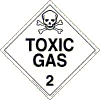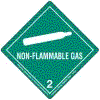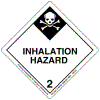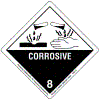Ammonia Solution, Ammonia, Anhydrous: Lung Damaging Agent
CAS #:
7664-41-7
RTECS #: BO0875000
UN #: 3318 and 1005 (Guide 125)
Common Names:
- Nitro-Sil
- AM-Fol
Agent Characteristics
Clear, colorless, gas. Clear, colorless liquid under pressure.
For the purposes of this card, ammonia refers to solutions that are 50% ammonia or greater, ammonia anhydrous, and ammonia anhydrous liquified, unless otherwise specified.
Ammonia is a toxic gas or liquid that, when concentrated, is corrosive to tissues upon contact. Exposure to ammonia in sufficient quantities can be fatal. One of the highest production-volume chemicals in the U.S., concentrated ammonia is used in manufacturing, refrigeration, and agriculture (as a fertilizer). Household ammonia is much less concentrated; it rarely causes burns, but it does cause irritation. The lowest level at which humans can detect the odor of ammonia (odor threshold) generally provides sufficient warning of exposure; however, persons with prolonged exposure to ammonia will lose their ability to detect the odor (olfactory fatigue). Ammonia commonly exists as part of a solution.
- Indoor Air: Ammonia can be released into indoor air as a liquid spray (aerosol) or as a vapor.
- Water: Ammonia can be used to contaminate water.
- Food: Ammonia is unlikely to contaminate food due to unpalatable qualities rendered to food.
- Outdoor Air: Ammonia can be released into outdoor air as a liquid spray (aerosol) or as a vapor.
- Agricultural: If ammonia is released into the air as a liquid spray (aerosol), it has the potential to contaminate agricultural products. If ammonia is released as a vapor, it is highly unlikely to contaminate agricultural products.
Ammonia can be absorbed into the body by inhalation, ingestion, eye contact, and skin contact. Ingestion is an uncommon route of exposure. Absorption by eye contact may be limited by severe corrosive injury and/or by significant spasmodic blinking (blepharospasm), even with mild exposures.
Personal Protective Equipment
First Responders should use a NIOSH-certified Chemical, Biological, Radiological, Nuclear (CBRN) Self Contained Breathing Apparatus (SCBA) with a Level A protective suit when entering an area with an unknown contaminant or when entering an area where the concentration of the contaminant is unknown. Level A protection should be used until monitoring results confirm the contaminant and the concentration of the contaminant.
NOTE: Safe use of protective clothing and equipment requires specific skills developed through training and experience.
Select when the greatest level of skin, respiratory, and eye protection is required. This is the maximum protection for workers in danger of exposure to unknown chemical hazards or levels above the IDLH or greater than the AEGL-2.
- A NIOSH-certified CBRN full-face-piece SCBA operated in a pressure-demand mode or a pressure-demand supplied air hose respirator with an auxiliary escape bottle.
- A Totally-Encapsulating Chemical Protective (TECP) suit that provides protection against CBRN agents.
- Chemical-resistant gloves (outer).
- Chemical-resistant gloves (inner).
- Chemical-resistant boots with a steel toe and shank.
- Coveralls, long underwear, and a hard hat worn under the TECP suit are optional items.
Select when the highest level of respiratory protection is necessary but a lesser level of skin protection is required. This is the minimum protection for workers in danger of exposure to unknown chemical hazards or levels above the IDLH or greater than AEGL-2. It differs from Level A in that it incorporates a non-encapsulating, splash-protective, chemical-resistant splash suit that provides Level A protection against liquids but is not airtight.
- A NIOSH-certified CBRN full-face-piece SCBA operated in a pressure-demand mode or a pressure-demand supplied air hose respirator with an auxiliary escape bottle.
- A hooded chemical-resistant suit that provides protection against CBRN agents.
- Chemical-resistant gloves (outer).
- Chemical-resistant gloves (inner).
- Chemical-resistant boots with a steel toe and shank.
- Coveralls, long underwear, a hard hat worn under the chemical-resistant suit, and chemical-resistant disposable boot-covers worn over the chemical-resistant suit are optional items.
Select when the contaminant and concentration of the contaminant are known and the respiratory protection criteria factors for using Air Purifying Respirators (APR) or Powered Air Purifying Respirators (PAPR) are met. This level is appropriate when decontaminating patient/victims.
- A NIOSH-certified CBRN tight-fitting APR with a canister-type gas mask or CBRN PAPR for air levels greater than AEGL-2.
- A NIOSH-certified CBRN PAPR with a loose-fitting face-piece, hood, or helmet and a filter or a combination organic vapor, acid gas, and particulate cartridge/filter combination or a continuous flow respirator for air levels greater than AEGL-1.
- A hooded chemical-resistant suit that provides protection against CBRN agents.
- Chemical-resistant gloves (outer).
- Chemical-resistant gloves (inner).
- Chemical-resistant boots with a steel toe and shank.
- Escape mask, face shield, coveralls, long underwear, a hard hat worn under the chemical-resistant suit, and chemical-resistant disposable boot-covers worn over the chemical-resistant suit are optional items.
Select when the contaminant and concentration of the contaminant are known and the concentration is below the appropriate occupational exposure limit or less than AEGL-1 for the stated duration times.
- Limited to coveralls or other work clothes, boots, and gloves.
Emergency Response
- A poisonous, visible vapor cloud is produced from contact of ammonia with water.
- Ammonia dissolves readily in water evolving heat (exothermic), to form ammonium hydroxide a corrosive, alkaline solution.
- Ammonia forms shock sensitive compounds with mercury, silver, and gold oxides.
- Ammonia reacts violently with strong oxidants, acids, halogens, and many heavy metals.
- Ammonia is corrosive to copper and galvanized surfaces.
- When ammonia is heated to decomposition, it emits toxic fumes and nitrogen oxides.
- Liquid ammonia will attack some forms of plastics, rubber, and coatings.
- When ammonia mixes with gas and/or air it forms an explosive mixture.
- Lower explosive (flammable) limit in air (LEL), 15%; upper explosive (flammable) limit in air (UEL), 28%.
- Containers may explode when heated.
- Ruptured cylinders may rocket.
- Ammonia is flammable.
- Fire will produce irritating, corrosive, and/or toxic gases.
- Never direct water jet straight at liquid ammonia.
- For small fires use dry chemical or carbon dioxide.
- For large fires use water spray, fog, or regular foam. Move containers from the fire area if possible to do so without risk to personnel. Do not get water inside containers. Damaged cylinders should be handled by a specialist only.
- For fire involving tanks, fight fire from a maximum distance or use unmanned hose holders or monitor nozzles. Cool containers with flooding quantities of water until well after fire is out. Do not direct water at source of leak or safety device; icing may occur. Withdraw immediately in case of rising sound from venting safety device or discoloration of tank. Always stay away from tanks engulfed in fire.
- Run-off from fire control may cause pollution.
- If the situation allows, control and properly dispose of run-off (effluent).
- When UN 1005 (anhydrous, liquefied), UN 2073 (35% to 50%), or UN 3318 (> 50%) is involved in a tank, rail car, or tank truck fire:
- Isolate it for 1 mi (1600 m) in all directions; also, consider initial evacuation for 1 mi (1600 m) in all directions.
- When UN 2672 (10% to 35%) is involved in a tank, rail car, or tank truck is fire:
- Isolate it for 0.5 mi (800 m) in all directions; also, consider initial evacuation for 0.5 mi (800 m) in all directions.
- When UN 1005 (anhydrous, liquefied) or UN 3318 (> 50%) is involved in small spills (involving the release of approximately 52.83 gallons (200 liters) or less):
- First isolate in all directions: 100 ft (30 m).
- Then protect persons downwind during the day: 0.1 mi (0.1 km).
- Then protect persons downwind during the night: 0.1 mi (0.1 km).
- When UN 1005 (anhydrous, liquefied) or UN 3318 (> 50%) is involved in large spills (involving quantities greater than 52.83 gallons (200 liters)):
- First isolate in all directions: 200 ft (60 m).
- Then protect persons downwind during the day: 0.4 mi (0.6 km).
- Then protect persons downwind during the night: 1.4 mi (2.2 km).
- When UN 2073 (35% to 50%) is involved:
- This agent is not included in the DOT ERG 2004 Table of Initial Isolation and Protective Action Distances.
- In the DOT ERG 2004 orange-bordered section of the guidebook, there are public safety recommendations to immediately isolate an ammonia (Guide 125) spill or leak area for at least 330 ft (100 m) in all directions.
- When UN 2672 (10% to 35%) is involved:
- This agent is not included in the DOT ERG 2004 Table of Initial Isolation and Protective Action Distances.
- In the DOT ERG 2004 orange-bordered section of the guidebook, there are public safety recommendations to immediately isolate an ammonia (Guide 154) spill or leak area for at least 150 ft (50 m) for liquids and 75 ft (25 m) for solids in all directions.
- Ammonia gas is lighter than air. However, under certain conditions, when compressed liquified ammonia gas initially escapes a cylinder and comes into contact with moisture in the air it will form an ammonia fog. This fog is likeley to remain low to the ground, and could prevent ammonia gas from rising in the air.
- Dangerous concentrations of ammonia gas will occur quickly in enclosed or poorly ventilated spaces.
- Health: 3
- Flammability: 1
- Reactivity: 0
- Special:

- OSHA: ID188
- NIOSH: 6015, 6016
- AIR MATRIX
Aneja PA, Murthy AB, Battye W, Battye R, Benjey WG [1998]. Analysis of ammonia and aerosol concentrations and deposition near the free troposhere at Mt. Mitchell, NC, U.S.A. Atmos Environ 32(3):353-358.Aneja VP, Bunton B, Walker JT, Malik BP [2001]. Measurement and analysis of atmospheric ammonia emissions from anaerobic lagoons. Atmos Environ 35(11):1949-1958. - OTHER
No references were identified for this sampling matrix for this agent. - SOIL MATRIX
Roelle PA, Aneja VP [2002]. Characterization of ammonia emissions from soils in the upper coastal plain, North Carolina. Atmos Environ 36(6):1087-1097.Thomas DH, Rey M, Jackson PE [2002]. Determination of inorganic cations and ammonium in environmental waters by ion chromatography with a high-capacity cation-exchange column. J Chromatogr A 956(1-2):181-186. - SURFACES
No references were identified for this sampling matrix for this agent. - WATER
Aoki T, Fukuda S, Hosoi Y, Mukai H [1997]. Rapid flow injection analysis method for successive determination of ammonia, nitrite, and nitrate in water by gas-phase chemiluminescence. Anal Chim Acta 349(1-3):11-16.Chen ECM, Farquharson RA [1979]. Analysis of trace quantities of ammonia and amines in aqueous solutions by reversed-phase high-performance liquid chromatography using m-toluoyl derivatives. J Chromatogr A 178(1):358-363.Moschou EA, Lasarte UA, Fouskaki M, Chaniotakis NA, Papandroulakis N, Divanach P [2000]. Direct electrochemical flow analysis system for simultaneous monitoring of total ammonia and nitrite in seawater. Aquacultural Eng 22(4):255-268.Teeter BK, Dejarme LE, Choudhury TK, Cooks RG, Kaiser RE [1994].
Determination of ammonia, ethanol and acetic acid in solution using membrane introduction mass spectrometry. Talanta 41(8):1237-1245.van Staden JF [1992]. Simultaneous flow-injection analysis for two components with on-line dialysis and gas diffusion in series. Determination of chloride and ammonia nitrogen in industrial effluent water. Anal Chim Acta 261(1-2):453-459.van Staden JF, Taljaard RE [1997]. Determination of ammonia in water and industrial effluent streams with the indophenol blue method using sequential injection analysis. Anal Chim Acta 344(3):281-289.Wellons SL, Carey MA [1978]. High-performance liquid chromatographic separation and quantitation of polyfunctional amines as their m-toluoyl derivatives. J Chromatogr A 154(2):219-225.
Signs/Symptoms
Effects occur rapidly following exposure to ammonia. Some respiratory symptoms may be delayed in onset.
Ammonia is a severe irritant of the eyes, respiratory tract, gastrointestinal (GI) tract, and skin. It reacts with the moisture in the moist linings of body passages and cavities (mucous membranes) to produce an alkaline solution, ammonium hydroxide. The extent of injury produced by exposure to ammonia depends on the duration of the exposure and the concentration of the gas or liquid.
- Mild to moderate: Rapid eye irritation and burning sensation.
- Severe: Severe corrosive eye injury, inflammation of the membranes of the eye (conjunctivitis), tear production (lacrimation), swelling and sloughing of the surface cells of the eye, and temporary or permanent blindness.
- Mild to moderate: Nausea, vomiting (emesis), abdominal pain, burns of mouth, throat, esophagus, and stomach.
- Severe: Swelling of lips, mouth, and voice box (larynx), severe corrosive damage or burns of mouth, throat and stomach.
- Ingestion does not normally result in whole-body (systemic) toxicity.
- Mild to moderate: Nausea, vomiting (emesis), abdominal pain, and burns of the mouth, throat, esophagus, and stomach.
- Severe: Swelling of the lips, mouth, and voice box (larynx) and severe corrosive damage or burns to the mouth, throat, and stomach.
- Ingestion does not normally result in whole-body (systemic) toxicity.
- Mild to moderate: Irritation, swelling, and mild or stinging pain.
- Severe: Pain, inflammation, blistering (vesication), tissue death (necrosis), and deep penetrating burns, especially on moist skin areas.
- Exposure to liquefied ammonia gas may cause frostbite injury and possibly severe burns with more localized deep tissue damage (ulcerations).
Decontamination
The purpose of decontamination is to make an individual and/or their equipment safe by physically removing toxic substances quickly and effectively. Care should be taken during decontamination, because absorbed agent can be released from clothing and skin as a gas. Your Incident Commander will provide you with decontaminants specific for the agent released or the agent believed to have been released.
The following are recommendations to protect the first responders from the release area:
- Position the decontamination corridor upwind and uphill of the hot zone.
- The warm zone should include two decontamination corridors. One decontamination corridor is used to enter the warm zone and the other for exiting the warm zone into the cold zone. The decontamination zone for exiting should be upwind and uphill from the zone used to enter.
- Decontamination area workers should wear appropriate PPE. See the PPE section of this card for detailed information.
- A solution of detergent and water (which should have a pH value of at least 8 but should not exceed a pH value of 10.5) should be available for use in decontamination procedures. Soft brushes should be available to remove contamination from the PPE.
- Labeled, durable 6-mil polyethylene bags should be available for disposal of contaminated PPE.
The following methods can be used to decontaminate an individual:
- Decontamination of First Responder:
- Begin washing PPE of the first responder using soap and water solution and a soft brush. Always move in a downward motion (from head to toe). Make sure to get into all areas, especially folds in the clothing. Wash and rinse (using cold or warm water) until the contaminant is thoroughly removed.
- Remove PPE by rolling downward (from head to toe) and avoid pulling PPE off over the head. Remove the SCBA after other PPE has been removed.
- Place all PPE in labeled durable 6-mil polyethylene bags.
- Decontamination of Patient/Victim:
- Remove the patient/victim from the contaminated area and into the decontamination corridor.
- Remove all clothing (at least down to their undergarments) and place the clothing in a labeled durable 6-mil polyethylene bag.
- Thoroughly wash and rinse (using cold or warm water) the contaminated skin of the patient/victim using a soap and water solution. Be careful not to break the patient/victim’s skin during the decontamination process, and cover all open wounds.
- Cover the patient/victim to prevent shock and loss of body heat.
- Move the patient/victim to an area where emergency medical treatment can be provided.
First Aid
Initial treatment is primarily supportive of respiratory and cardiovascular function.
There is no antidote for ammonia toxicity.
- Immediately remove the patient/victim from the source of exposure.
- Immediately wash eyes with large amounts of tepid water for at least 15 minutes.
- Seek medical attention immediately.
- Immediately remove the patient/victim from the source of exposure.
- Ensure that the patient/victim has an unobstructed airway.
- Do not induce vomiting (emesis).
- Administer nothing by mouth (NPO).
- Administer supplemental oxygen and assist ventilation as needed.
- Monitor fluid and electrolyte balance and restore if abnormal.
- Seek medical attention immediately.
- Immediately remove the patient/victim from the source of exposure.
- Evaluate respiratory function and pulse.
- Ensure that the patient/victim has an unobstructed airway.
- If shortness of breath occurs or breathing is difficult (dyspnea), administer oxygen.
- Assist ventilation as required. Always use a barrier or bag-valve-mask device.
- If breathing has ceased (apnea), provide artificial respiration.
- In cases of respiratory compromise, secure airway and respiration by inserting a tube within the trachea (endotracheal intubation).
- Use caution when administering intravenous (IV) fluids when fluid accumulation in the lungs (pulmonary edema) is present.
- Seek medical attention immediately.
- Immediately remove the patient/victim from the source of exposure.
- See the decontamination section for patient/victim decontamination procedures.
- Treat any chemical burns with standard burn therapy.
- Seek medical attention immediately.
Long-Term Implications
For inhalation exposure, the treatment of accumulated fluid in the lungs (pulmonary edema), irritation of the large airways (bronchitis), and inflammatory lung disease (pneumonia) should occur within a hospital setting. Fluid and electrolyte balance should be monitored and restored if abnormal. For ingestion exposure, endoscopic examination of the stomach has been recommended following severe ingestions and in symptomatic patients/victims. Insertion of a naso- or orogastric tube to suction stomach contents may be considered following endoscopy.
Survivors of severe inhalation injury may suffer residual chronic lung disease. In cases of eye contact, tissue damage (ulceration) may result in late perforation of the cornea after weeks or months. Blindness may ensue. Cataracts and glaucoma have been reported in persons acutely exposed to high concentrations of ammonia. Permanent effects of ammonia ingestion on the digestive tract are due to damage to the moist lining (mucous membranes) of the digestive tract, and may include bleeding (hemorrhage), rupture (perforation), scarring, or abnormal narrowing (stricture formation).
Information regarding ammonia’s potential as a carcinogen, developmental toxin or reproductive toxin from chronic or repeated exposure is inconclusive. Chronic or repeated exposure to ammonia may cause chronic respiratory tract irritation, chronic cough, asthma, lung fibrosis, headaches, somnolence, chronic eye membrane irritation, and dermatitis.
On-Site Fatalities
- Consult with the Incident Commander regarding the agent dispersed, dissemination method, level of PPE required, location, geographic complications (if any), and the approximate number of remains.
- Coordinate responsibilities and prepare to enter the scene as part of the evaluation team along with the FBI HazMat Technician, local law enforcement evidence technician, and other relevant personnel.
- Begin tracking remains using waterproof tags.
- Wear PPE until all remains are deemed free of contamination.
- Establish a preliminary (holding) morgue.
- Gather evidence, and place it in a clearly labeled impervious container. Hand any evidence over to the FBI.
- Remove and tag personal effects.
- Perform a thorough external evaluation and a preliminary identification check.
- See the Decontamination section for decontamination procedures.
- Decontaminate remains before they are removed from the incident site.
Occupational Exposure Limits
- NIOSH REL:
- TWA (10-hour): 25 ppm (18 mg/m3)
- STEL (15-minute): 35 ppm (27 mg/m3)
- OSHA PEL:
- TWA (8-hour): 50 ppm (35 mg/m3)
- ACGIH TLV:
- TWA (8-hour): 25 ppm
- STEL (15-minute): 35 ppm
- NIOSH IDLH: 300 ppm
- DOE TEEL:
- TEEL-0: 15 mg/m3
- TEEL-1: 20.9 mg/m3
- TEEL-2: 111 mg/m3
- TEEL-3: 766 mg/m3
- AIHA ERPG:
- ERPG-1: 25 ppm
- ERPG-2: 150 ppm
- ERPG-3: 750 ppm
Acute Exposure Guidelines
| 10 min | 30 min | 60 min | 4 hr | 8 hr | |
|---|---|---|---|---|---|
| AEGL 1 (discomfort, non-disabling) – ppm |
30 ppm | 30 ppm | 30 ppm | 30 ppm | 30 ppm |
| AEGL 2 (irreversible or other serious, long-lasting effects or impaired ability to escape) – ppm |
220 ppm | 220 ppm | 160 ppm | 110 ppm | 110 ppm |
| AEGL 3 (life-threatening effects or death) – ppm |
2,700 ppm | 1,600 ppm | 1,100 ppm | 550 ppm | 390 ppm |
Decontamination (Environment and Equipment)
The following methods can be used to decontaminate the environment/spillage disposal:
- Do not touch or walk through the spilled agent if at all possible. However, if you must, personnel should wear the appropriate PPE during environmental decontamination. See the PPE section of this card for detailed information.
- Keep combustibles (e.g., wood, paper, and oil) away from the spilled agent.
- Use water spray to reduce vapors or divert vapor cloud drift. Avoid allowing water runoff to contact the spilled agent.
- Do not direct water at the spill or the source of the leak.
- Stop the leak if it is possible to do so without risk to personnel, and turn leaking containers so that gas rather than liquid escapes.
- Prevent entry into waterways, sewers, basements, or confined areas.
- Isolate the area until gas has dispersed.
- Ventilate the area.
Agents can seep into the crevices of equipment making it dangerous to handle. The following methods can be used to decontaminate equipment:
- Not established/determined
Agent Properties
- Chemical Formula:
NH3 - Aqueous solubility:
Soluble - Boiling Point:
-28°F (-33.35°C) - Density:
Gas: 0.5967 (air = 1) - Flammability:
Not flammable - Flashpoint:
Not established/determined
- Ionization potential: 10.1 eV
- Log Kbenzene-water:
Not established/determined - Log Kow (estimated):
0.23 - Melting Point:
-108°F (-77.7°C) - Molecular Mass:
17.03
- Soluble In: Chloroform, ether
- Specific Gravity:
Gas: 0.7710 at 760 mm Hg - Vapor Pressure:
8.5 atm - Volatility:
Not established/determined
Hazardous Materials Warning Labels/Placards
- Shipping Name:
Ammonia solution, relative density less than 0.880 at 15 degrees C in water, with more than 50 percent ammonia (UN 3318)
Ammonia, anhydrous (UN 1005) - Identification Number:
3318 and 1005 (Guide 125) - Hazardous Class or Division:
For domestic: 2.2 (UN 3318 and UN 1005)
For international: 2.3 (UN 3318 and UN 1005) - Subsidiary Hazardous Class or Division:
For domestic: 2.2 (UN 3318 and UN 1005)
For international: 2.3, 8 (UN 3318 and UN 1005) - Label:
For domestic: Inhalation Hazard; Toxic Gas (UN 3318 and UN 1005)
For internationally: Poison (Toxic) Gas, Corrosive (UN 3318 and UN 1005) - Placard Image:

Trade Names and Other Synonyms
- AM-Fol
- Ammonia Anhydrous
- Ammonia Gas
- Ammonia solution
- Ammoniac (French)
- Ammoniaca (Italian)
- Ammoniak (German)
- Ammoniak Kconzentrierter
- Ammoniakgas
- Ammonium hydroxide
- Amoniak (polish)
- Anhydrous Ammonia
- Aqua Ammonia
- Aqueous Ammonia
- Liquid Ammonia
- Nitro-Sil
- R 717
- Refrigerant R717
- Spirit of hartshorn
In the event of a poison emergency, call the poison center immediately at 1-800-222-1222. If the person who is poisoned cannot wake up, has a hard time breathing, or has convulsions, call 911 emergency services.
For information on who to contact in an emergency, see the CDC website at emergency.cdc.gov or call the CDC public response hotline at (888) 246-2675 (English), (888) 246-2857 (Español), or (866) 874-2646 (TTY).
The user should verify compliance of the cards with the relevant STATE or TERRITORY legislation before use. NIOSH, CDC 2003.



